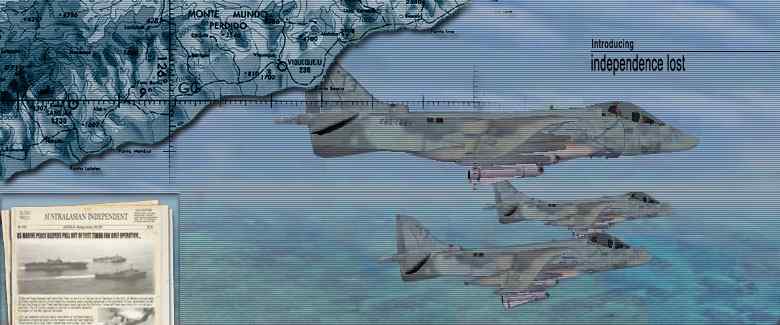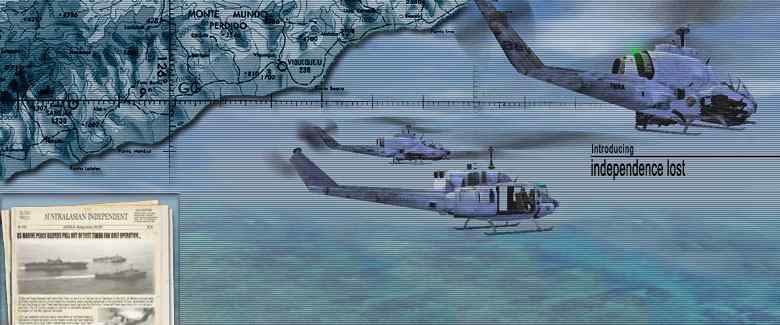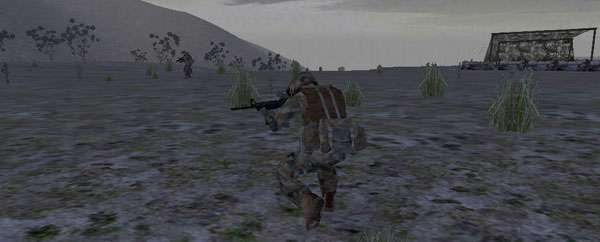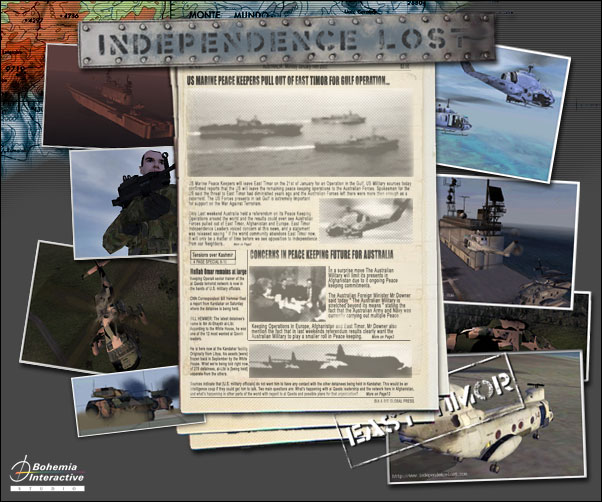
Update: June 11, 2003:
Ever since BIS' announcement of OFP2, the fate of Independence Lost has been hanging in the air. But there's good news now! Looking at Independence Lost's official WEB site, the main splash screen picture's lower right hand corner now states that Independence Lost is delayed until after OFP2 is released.
Update: February 4, 2003:
Independence Lost's official WEB site is being constantly updated by BIS. You can now view the storyline again on the site's history page. There's a navigation bar there that will take you to other pages, including the screenshot gallery page. Still, most of the pages are still under construction but we're patient, aren't we?
Update: February 4, 2003:
I discovered that Independence Lost's official WEB site now has a screens gallery folder. Here's a rundown of the files available so far:
There are a number of pictures that, when put together, produce 2 separate splash screens for IL:


The newspaper clipping on the lower left just happened to fit in. This may not be the clipping's true position. The background map is a real map of East Timor. I'm just curious as to whether the entire island will be made available in IL. In real life, East Timor is several hundred kilometers long.
A navigation bar is also present:
![]()
There are also several menu button pics present:
![]()
![]()
![]()
![]()
![]()
![]()
Regarding the Santa Cruz Massace button, you should refer to IL's complete original storyline, below, for some historical background.
Update: February 3, 2003:
Independence Lost's official WEB site came back online for the first time in over half a year.
Update: February 3, 2003:
OFP reg Vixer just pointed out something very interesting to all of us.
Click on one of the thumbnails of Seventh Australia's site's new splash screen, below, and you'll see what I mean. For those that don't know it yet, Seventh is the band that contributed OFP's rock music scores. In addition, Seventh's leader, David Lagettie, has been associated with BIS' Australian team. You didn't know they had one? Tsk. Whatever is know to date about Independence Lost can be found in this FAQ item.
Update: January 5, 2003:
It doesn't really come as a surprise to me but I can now state with a lot more certainty than what I've previously stated below that Independence Lost is anything but dead. Now stop hyperventilating and calm down because that's about all I can tell you and, in fact, that's about all that I know. I'm not even sure if the pic right below is from Independence Lost but it just might be.

On January 28 2002, the Independence Lost (IL for short) WEB site went public. Then, since the summer of 2002, it has been down. The rest of this FAQ item assumes that IL's site or its eventual replacement will be back up when BIS and CM are approaching IL's publication. Of course, I'm also assuming that IL will indeed be released. That's what my intuition tells me for the moment. Now, back to our show..................................
IL, being produced directly by BIS, is a planned OFP expansion pack or a new OFP version or OFP-like product, scheduled for general availability later this year. This is not to be confused with an already planned expansion pack, OFP: Resistance, being produced by Bohemia Interactive Studios and announced by Codemasters as going to be available in June 2002.
IL will contain reskinned versions of existing vehicles and aircraft as well as new naval craft, such as an aircraft carrier, the Sea Stallion and Huey choppers and the Harrier jet. There will also be Australian forces as well as others. Several of the units pictured in IL's splash screen, below, first appeared on Virtual Battlefield Systems' site.
IL's screenshot gallery has disappeared for the moment. We hope BIS will decide to put it back up soon, though the pictures below will give you a good idea of what to expect from IL.
IL's storyline takes place in East Timor, which was annexed by Indonesia in 1976. More historical background information used to be on IL's site but has since been removed. However, yours truly managed to procure the complete original storyline for your reading pleasure. Whether IL's game mission scenarios take place in the 1990's or in the 2000's remains to be seen.
BIS is being very tight-lipped about how IL will be packaged. Is it an expansion pack for current OFP version 1? Is it part of a new OFP version 2? Or maybe it's a separate sister product of OFP's altogether? In this BONUSWEB.CZ interview, BIS' Marek Spanel refuses to say more than whatever's revealed on IL's site. Loose lips sink ships, I suppose.
In another interview with Computer & Video Games, Marek spilled a few more beans, saying that IL is being developed by BIS' new Australian studio. Among those involved, at least in WEB design and possibly in music and more, is Seventh, who is Australian by coincidence. You may recall that Seventh composed some of OFP's music. I'm aware of someone else joining BIS' Australian forces but he's still stuck in the western hemisphere for the moment.
I'll keep you posted as I get updated information about IL. Heard something that didn't pass my way? Let me know.

If you didn't catch it on IL's site before it was removed, here is the original storyline text:
East Timor has earned a bloody reputation out of all proportion to its size. This small territory is a former Portuguese colony which Indonesia invaded in 1975 in the midst of decolonization. The move had tacit support from Western powers convinced by Jakarta that East Timor risked becoming a communist satellite. Indonesia's formal annexation of the territory in 1976 was never accepted by the United Nations.
In December 1975 the Indonesian army invaded the town of Batugadé. The East Timorese resisted this invasion. On 7 December 1975 the Indonesian army landed in Dili, one day after US President Gerald Ford and Secretary of State Henry Kissinger departed from a summit meeting in Jakarta. The invasion commenced with a naval bombardment, followed by paratroopers and finally beach landings. Civilians were killed, shops looted, women raped and public executions took place on the wharf. On 10 December 1975 the town of Baucau was captured, followed by Liquica and Maubara, where further mass killings of civilians reportedly took place. One estimation is that within four months up to 100, 000 people were killed. A Portuguese source claims that 44% of the pre-occupation population was killed between the invasion and 1981.
A provisional Timorese government was immediately established, consisting of APODETI ministers. A petition was signed by 28 conscripted delegates asking President Suharto to grant East Timor integration with Indonesia. On 17 July 1976 Suharto signed the Bill of Integration and declared East Timor to be Indonesia’s 27th province.
On the evening of 27th October 1991, at a church service in the Church of St.Antonio de Motael, 18 year old Sebastio Gomes Rangel was shot and killed by ABRI soldiers. One other Timorese was also killed during that evening. At a memorial mass in Dili on 12thNovember 1991, as the procession moved to the Santa Cruz cemetery, some in the crowd carried pro-independence flags and banners. During this march, seven Western journalists, including US citizens Allan Nairn and Amy Goodman, witnessed Indonesian soldiers open fire on hundreds of unarmed demonstrators at the cemetery. A British photographer actually captured the rampage on video. Nairn and Goodman, who had tried to place themselves between the soldiers and the people, were threatened at gunpoint and beaten. Many of the wounded were reportedly taken away on military vehicles and killed. Initial eyewitness accounts claimed at least 100 people were killed; subsequent investigation by an East Timorese organization (Peace Is Possible in East Timor) has identified 271 victims by name. It is also estimated that 382 people were wounded and 250 disappeared. An Indonesian enquiry found that 19 people were killed and that the incident was in response to rioting by the mourners.
On 30 August 1999 a UN administered ballot resulted in a 78.5% vote by an estimated 98.6% of the eligible population against greater autonomy within Indonesia. As a result, the Indonesian military and pro-Indonesia militias engulfed East Timor in violence. Hundreds of East Timorese were killed. Estimates state that 75% of the population were again displaced either into the mountains or to West Timor. Those in the mountains faced starvation and those that fled into West Timor (estimated at 200, 000) were forcibly held in squalid refugee camps. Widespread looting and destruction of property occurred throughout the country, including the destruction of in excess of 50% of homes in Dili. It was reported by International newspapers that 145 people were killed in Dili within 48 hours of the ballot declaration.
On 15 September 1999 the UN Security Council authorized a multi-national peace enforcement mission in East Timor (INTERFET), to restore peace and security and to facilitate humanitarian relief efforts. 7000 troops led by Australia secured East Timor, with the exception of the Oecusse enclave – which was secured in mid-October 1999. International relief efforts were put in place and displaced people were permitted to return to their communities. Indonesian forces were withdrawn from East Timor. On 20 October 1999 the Indonesian Parliament resolved to formally ratify East Timor’s separation from Indonesia allowing the UN Security Council to approve the establishment of a UN Transitional Administration in East Timor (UNTAET).
UNTAET’s principal role is to facilitate the transition of East Timor to independence. It is responsible for the administration of East Timor including the exercise of all legislative and executive authority, the administration of justice and the organizing of elections. In February 2000 INTERFET formally handed over administration to UNTAET.
By its resolution 1338 of 31 January 2001, the Security Council extended the mandate of UNTAET until 31 January 2002, bearing in mind the possible need for adjustments related to the independence timetable.